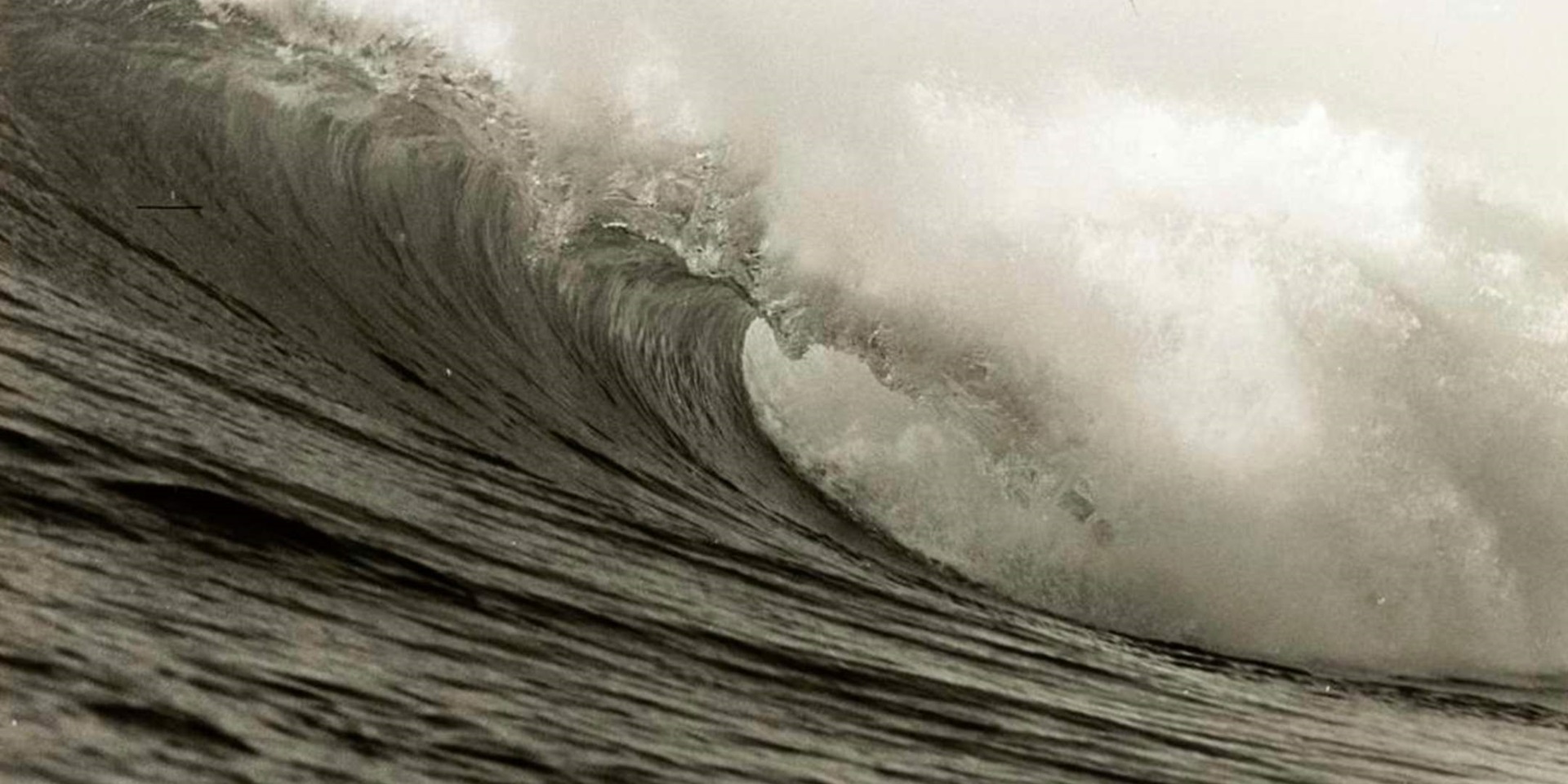
![Jack Eden, Bernard ‘Midget’ Farrelly in action at the first world open surfboard championships Manly, May 1964. ANMM Collection ANMS1078[002] Gift from Jack and Dawn Eden.](https://s3-ap-southeast-2.amazonaws.com/anmm-data/blog/2017/06/13/anms1078002.jpg)
Jack Eden, Bernard ‘Midget’ Farrelly in action at the first world open surfboard championships Manly, May 1964. ANMM Collection ANMS1078[002] Gift from Jack and Dawn Eden.
18-year-old Australian surfer Bernard ‘Midget’ Farrelly’s victory in Hawaii in 1963 positioned him, in a very real sense, as the human ‘winged keel’ in forging a golden moment in Australia’s sporting folklore. As an outsider, a small wave rider from the southern hemisphere, Farrelly bettered the champion big wave surfers from Hawaii and North America to win the famed Makaha championship in Hawaii, surfing’s spiritual home, becoming the first non-Hawaiian to do so.
A huge name among surfers then and now, Farrelly, from Sydney’s northern beaches, became an instant celebrity when he won the stunning carved timber trophy and even more so when he bettered this at the first world titles held the following year in Manly.
The Makaha trophy was surfing’s holy grail, sponsored by the Waikiki Surf Club and widely regarded at the time as the unofficial world title. This trophy, along with the First world open surfboard championships title trophy won in Manly in May 1964, have recently been presented to the museum. They are now on display for the first time since they were awarded to Farrelly 60 years ago, in a feature space called Out of Hawaii.
Surfing captured the cultural zeitgeist in 1960s Australia and the two stunning trophies evoke the sport’s heritage, aspirations and heroes. In Australia during 1962, several surfing magazines hit the newsstands, among them photographer Jack Eden’s Surfabout and Bob Evans’s Surfing World. With this and Evans’s work as a filmmaker, the movement now had an effective and thrilling voice. The sights, sounds, styles, energies and politics of surfing culture exploded. Especially in popular music. Wipeout!
The carved timber surfing warrior evokes the strength, dominance and heritage of surfing as a Hawaiian cultural practice, while the first world titles trophy, composed of silver plated surfers atop the world globe, testifies to the aspirations of its organisers who saw surfing as an international sport.
In 1961 a group of 20 Australian surfers had visited Hawaii for its huge waves and the famed Makaha surfing contest on the west coast of Oahu. Among them was a young 16-year-old Bernard Farrelly, known as ‘Midget’, then junior champion and a surfboard builder by trade, Bob Pike who was chasing the big waves, and the oldest rider, organiser Bob Evans. All lost to the dominant locals. The next year Farrelly returned and won, beating the favoured Surfers, Hawaiian Joey Cabell and Californian Mike Doyle, in the coveted tenth annual Makaha surfing contest. At the time it was surfing’s supreme test. Aside from the large numbers of local surfers, the event drew competitors from North America, Great Britain, France and New Zealand and Peru. Later that year Cabell won the trophy back, Farrelly was unplaced.
![ANMS1078[005] Jack Eden, The crowd at the first world open surfboard championships Manly, 1964. ANMM Collection 1078[005].](https://s3-ap-southeast-2.amazonaws.com/anmm-data/blog/2017/06/13/anms1078005.jpg)
![ANMS1078[004] Jack Eden, Presentation of the trophies in the first world open surfboard championships Manly, 1964. Gelatin silver photograph, printed 1990s. Senior men’s championship winners on the podium: 1 Midget Farrelly, Australia (centre), 2 Mike Doyle, California (left), 3 Joey Cabell, Hawaii (right). The women’s championship winners are on the right: 1 Australian Phyllis O’Donnell (far right) and 2 Linda Benson California (right), with Nat Young, the runner-up in the junior men’s final, on the left. ANMM Collection ANMS1078[004], ANMM Collection Gift from Jack and Dawn Eden.](https://s3-ap-southeast-2.amazonaws.com/anmm-data/blog/2017/06/13/anms1078004.jpg)
In May 1964, all three surfers reunited in competition to hit the waves on Sydney’s Manly Beach in the first world surfing championship in an event widely feted by the local press, local government officials and spectators of all persuasions. Incredibly a crowd of 60,000 packed Manly’s beachfront over the three days the event was held. From an international field, a panel of international judges awarded the points to Californians Mike Doyle and ‘Little’ John Richards, Hawaiian Joey Cabell, and Australians Bobby Brown and Midget Farrelly who made the finals.
‘Two almost perfect rides yesterday won Sydney surfer Bernard ‘Midget’ Farrelly the world surfboard riding championships at Manly in a hard fought final [with] Farrelly’s tight functional surfing hard-up against the curl,’ reported The Sydney Morning Herald of 18 May 1964.
Farrelly won the silver-plated world globe trophy for the senior men’s title. Fellow Australian Phyllis O’Donnell won the women’s title, ahead of Californian surfer, and ‘Gidget’ surfing movie double Linda Benson. Out of this event the International Surfing Federation was formed and the following year the first authorised, official international titles were held in Peru.
Bernard Farrelly, possessed of a ‘superhuman elegance’ according to a contemporary magazine, was a surfing legend – a star of TV with his Midget Farrelly Surf show, and film, a surfing correspondent and author, and designer and shaper of surf and skateboards. As ABC Four Corners documentary reported after the world title victory in 1964 ‘Midget Farrelly has become the idol of the blossoming surfie cult and through his newspaper column published in several states has preached his gospel of the waves…’ which involves, quoting Farrelly ‘things like… walking, if I can get a little bit technical, stalling, turning, trimming, nose-riding, climb and dropping, cut-backs, drop-ins, all these sort of things. You have to put them together to fit the wave.’
![Jack Eden, Portrait of Bernard Farrelly, 1963. ANMM Collection ANMS1078[001], ANMM Collection Gift from Jack and Dawn Eden.](https://s3-ap-southeast-2.amazonaws.com/anmm-data/blog/2017/06/13/anms1078001.jpg)
Jack Eden, Portrait of Bernard Farrelly, 1963. ANMM Collection ANMS1078[001], ANMM Collection Gift from Jack and Dawn Eden.
Both surfers are legends in Australia. In recent years visiting Hawaiian delegations met Farrelly, on one occasion paddling out from Sydney’s Freshwater Beach, 100 years after Kahanamoku’s visit, to pay homage to the friendship between Hawaii and Australian-born of the waves. The Makaha trophy is draped with seed offerings presented to him.
The two trophies that put Australia on the world surfing map are on display now at the museum.
—Daina Fletcher, Senior Curator.
See the sensational surfing trophies with our FREE galleries ticket.






![ANMS1078[003] Jack Eden, Big wave at Cronulla Point, 1963. ANMM Collection ANMS1078[003], ANMM Collection Gift from Jack and Dawn Eden.](https://s3-ap-southeast-2.amazonaws.com/anmm-data/blog/2017/06/13/anms1078003.jpg)


